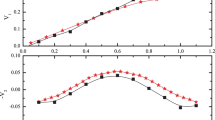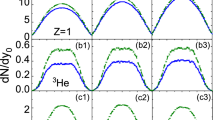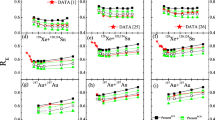Abstract
The effects of the in-medium nucleon–nucleon (NN) elastic cross section on the observables in heavy ion collisions in the Fermi energy domain are investigated within the framework of the ultrarelativistic quantum molecular dynamics model. The results simulated using medium correction factors of \({\mathcal{F}}=\sigma ^{\mathrm{in-medium}}_\mathrm{NN}/ \sigma ^{\mathrm{free}}_\mathrm{NN}=0.2,~0.3,~0.5,\) and the density- and momentum-dependent factor obtained from the FU3FP1 parametrization are compared with the FOPI and INDRA experimental data. It is found that the calculations using the correction factors \({\mathcal{F}} =\) 0.2 and 0.5 reproduce the experimental data (i.e., collective flow and nuclear stopping) at 40 and 150 MeV/nucleon, respectively. Calculations with the FU3FP1 parametrization can best fit these experimental data. These conclusions can be confirmed in both \(^{197}\text{Au}+^{197}\text{Au}\) and \(^{129}\text{Xe}+^{120}\text{Sn}\).






Similar content being viewed by others
References
J. Aichelin, “Quantum” molecular dynamics—a dynamical microscopic n-body approach to investigate fragment formation and the nuclear equation of state in heavy ion collisions. Phys. Rep. 202, 233 (1991). https://doi.org/10.1016/0370-1573(91)90094-3
G.F. Bertsch, S. Das Gupta, A guide to microscopic models for intermediate energy heavy ion collisions. Phys. Rep. 160, 189 (1988). https://doi.org/10.1016/0370-1573(88)90170-6
J. Xu, L.W. Chen, M.B. Tsang et al., Understanding transport simulations of heavy-ion collisions at \(100A\) and \(400A\) MeV: comparison of heavy-ion transport codes under controlled conditions. Phys. Rev. C 93, 044609 (2016). https://doi.org/10.1103/PhysRevC.93.044609
Y.X. Zhang, Y.J. Wang, M. Colonna et al., Comparison of heavy-ion transport simulations: collision integral in a box. Phys. Rev. C 97, 034625 (2018). https://doi.org/10.1103/PhysRevC.97.034625
Z.F. Zhang, D.Q. Fang, Y.G. Ma, Decay modes of highly excited nuclei. Nucl. Sci. Tech. 29, 78 (2018). https://doi.org/10.1007/s41365-018-0427-8
P. Danielewicz, R. Lacey, W.G. Lynch, Determination of the equation of state of dense matter. Science 298, 1592 (2002). https://doi.org/10.1126/science.1078070
X.G. Deng, Y.G. Ma, Electromagnetic field effects on nucleon transverse momentum for heavy ion collisions around 100?\(A\)?MeV. Nucl. Sci. Tech. 28, 182 (2017). https://doi.org/10.1007/s41365-017-0337-1
Y.J. Wang, C.C. Guo, Q.F. Li, A. Le Fèvre, Y. Leifels, W. Trautmann, Determination of the nuclear incompressibility from the rapidity-dependent elliptic flow in heavy-ion collisions at beam energies 0.4 A–1.0 A GeV. Phys. Lett. B 778, 207 (2018). https://doi.org/10.1016/j.physletb.2018.01.035
H.M. Xu, Disappearance of flow and the in-medium nucleon–nucleon cross section. Phys. Rev. C 46, R389 (1992). https://doi.org/10.1103/PhysRevC.46.R389
G.D. Westfall, W. Bauer, D. Craig et al., Mass dependence of the disappearance of flow in nuclear collisions. Phys. Rev. Lett. 71, 1986 (1993). https://doi.org/10.1103/PhysRevLett.71.1986
B.A. Li, A.T. Sustich, Differential flow in heavy-ion collisions at balance energies. Phys. Rev. Lett. 82, 5004 (1999). https://doi.org/10.1103/PhysRevLett.82.5004
D.J. Magestro, W. Bauer, G.D. Westfall, Isolation of the nuclear compressibility with the balance energy. Phys. Rev. C 62, 041603 (2000). https://doi.org/10.1103/PhysRevC.62.041603
J.Y. Liu, W.J. Guo, S.J. Wang et al., Nuclear stopping as a probe for in-medium nucleon–nucleon cross sections in intermediate energy heavy ion collisions. Phys. Rev. Lett. 86, 975 (2001). https://doi.org/10.1103/PhysRevLett.86.975
D. Persram, C. Gale, Elliptic flow in intermediate energy heavy ion collisions and in-medium effects. Phys. Rev. C 65, 064611 (2002). https://doi.org/10.1103/PhysRevC.65.064611
T. Gaitanos, C. Fuchs, H.H. Wolter, Nuclear stopping and flow in heavy-ion collisions and the in-medium NN cross section. Phys. Lett. B 609, 241 (2005). https://doi.org/10.1016/j.physletb.2005.01.069
B.A. Li, P. Danielewicz, W.G. Lynch, Probing the isospin dependence of the in-medium nucleon–nucleon cross sections with radioactive beams. Phys. Rev. C 71, 054603 (2005). https://doi.org/10.1103/PhysRevC.71.054603
B.A. Li, L.W. Chen, Nucleon–nucleon cross sections in neutron-rich matter and isospin transport in heavy-ion reactions at intermediate energies. Phys. Rev. C 72, 064611 (2005). https://doi.org/10.1103/PhysRevC.72.064611
Q.F. Li, Z.X. Li, S. Soff et al., Medium modifications of the nucleon–nucleon elastic cross section in neutron-rich intermediate energy HICs. J. Phys. G Nucl. Part. Phys. 32, 407 (2006). https://doi.org/10.1088/0954-3899/32/4/001
Y.X. Zhang, Z.X. Li, Elliptic flow and system size dependence of transition energies at intermediate energies. Phys. Rev. C 74, 014602 (2006). https://doi.org/10.1103/PhysRevC.74.014602
Y.X. Zhang, Z.X. Li, P. Danielewicz, In-medium \(\rm NN\) cross sections determined from the nuclear stopping and collective flow in heavy-ion collisions at intermediate energies. Phys. Rev. C 75, 034615 (2007). https://doi.org/10.1103/PhysRevC.75.034615
Y. Yuan, Q.F. Li, Z.X. Li et al., Transport model study of nuclear stopping in heavy-ion collisions over the energy range from \(0.09A\) to \(160A\) GeV. Phys. Rev. C 81, 034913 (2010). https://doi.org/10.1103/PhysRevC.81.034913
G.Q. Zhang, Y.G. Ma, X.G. Cao et al., Unified description of nuclear stopping in central heavy-ion collisions from 10\(A\) MeV to 1.2\(A\) GeV. Phys. Rev. C 84, 034612 (2011). https://doi.org/10.1103/PhysRevC.84.034612
D.D.S. Coupland, W.G. Lynch, M.B. Tsang et al., Influence of transport variables on isospin transport ratios. Phys. Rev. C 84, 054603 (2011). https://doi.org/10.1103/PhysRevC.84.054603
Z.Q. Feng, Nuclear in-medium effects and collective flows in heavy-ion collisions at intermediate energies. Phys. Rev. C 85, 014604 (2012). https://doi.org/10.1103/PhysRevC.85.014604
Y.X. Zhang, D.D.S. Coupland, P. Danielewicz et al., Influence of in-medium \(\rm {NN}\) cross sections, symmetry potential, and impact parameter on isospin observables. Phys. Rev. C 85, 024602 (2012). https://doi.org/10.1103/PhysRevC.85.024602
J. Su, ChY Huang, W.J. Xie et al., Effects of in-medium nucleon–nucleon cross sections on stopping observable and ratio of free protons in heavy-ion collisions at 400 MeV/nucleon. Eur. Phys. J. A 52, 207 (2016). https://doi.org/10.1140/epja/i2016-16207-x
W.G. Love, M.A. Franey, Effective nucleon–nucleon interaction for scattering at intermediate energies. Phys. Rev. C 24, 3 (1981). https://doi.org/10.1103/PhysRevC.24.1073
G.Q. Li, R. Machleidt, Microscopic calculation of in-medium nucleon–nucleon cross sections. Phys. Rev. C 48, 1702 (1993). https://doi.org/10.1103/PhysRevC.48.1702
G.Q. Li, R. Machleidt, Microscopic calculation of in-medium proton–proton cross sections. Phys. Rev. C 49, 566 (1994). https://doi.org/10.1103/PhysRevC.49.566
G.J. Mao, Z.X. Li, Y.Z. Zhuo et al., Medium effects on the NN inelastic cross section in relativistic heavy-ion collisions. Phys. Lett. B 327, 183 (1994). https://doi.org/10.1016/0370-2693(94)90715-3
G.J. Mao, Z.X. Li, Y.Z. Zhuo et al., Study of in-medium NN inelastic cross section from relativistic Boltzmann–Uehling–Uhlenbeck approach. Phys. Rev. C 49, 3137 (1994). https://doi.org/10.1103/PhysRevC.49.3137
T. Alm, G. Röpke, W. Bauer et al., The in-medium nucleon–nucleon cross section and BUU simulations of heavy-ion reactions. Nucl. Phys. A 587, 815 (1995). https://doi.org/10.1016/0375-9474(95)00026-W
H.J. Schulze, A. Schnell, G. Ropke et al., Nucleon–nucleon cross sections in nuclear matter. Phys. Rev. C 55, 3006 (1997). https://doi.org/10.1103/PhysRevC.55.3006
C. Fuchs, A. Faessler, M. El-Shabshiry, Off-shell behavior of the in-medium nucleon–nucleon cross section. Phys. Rev. C 64, 024003 (2001). https://doi.org/10.1103/PhysRevC.64.024003
F. Sammarruca, P. Krastev, Effective nucleon–nucleon cross sections in symmetric and asymmetric nuclear matter. Phys. Rev. C 73, 014001 (2006). https://doi.org/10.1103/PhysRevC.73.014001
H.F. Zhang, Z.H. Li, U. Lombardo et al., Nucleon–nucleon cross sections in dense nuclear matter. Phys. Rev. C 76, 054001 (2007). https://doi.org/10.1103/PhysRevC.76.054001
H.F. Zhang, U. Lombardo, W. Zuo, Transport parameters in neutron stars from in-medium NN cross sections. Phys. Rev. C 82, 015805 (2010). https://doi.org/10.1103/PhysRevC.82.015805
Q.F. Li, Z.X. Li, G.J. Mao, Isospin dependence of nucleon–nucleon elastic cross section. Phys. Rev. C 62, 014606 (2000). https://doi.org/10.1103/PhysRevC.62.014606
Q.F. Li, Z.X. Li, E.G. Zhao, Density and temperature dependence of nucleon–nucleon elastic cross section. Phys. Rev. C 69, 017601 (2004). https://doi.org/10.1103/PhysRevC.69.017601
Q.F. Li, Z.X. Li, The isospin dependent nucleon–nucleon inelastic cross section in the nuclear medium. Phys. Lett. B 773, 557 (2017). https://doi.org/10.1016/j.physletb.2017.09.013
J. Chen, Z.Q. Feng, J.S. Wang, Nuclear in-medium effects on \(\eta\) dynamics in proton–nucleus collisions. Nucl. Sci. Tech. 27, 73 (2016). https://doi.org/10.1007/s41365-016-0069-7
O. Lopez, D. Durand, G. Lehaut et al., (INDRA Collaboration), In-medium effects for nuclear matter in the Fermi-energy domain. Phys. Rev. C 90, 064602 (2014). https://doi.org/10.1103/PhysRevC.90.064602
B. Rubina, K. Mandeep, K. Suneel, Correlation between directed transverse flow and nuclear stopping around the energy of vanishing flow. Indian J. Phys. 89, 967 (2015). https://doi.org/10.1007/s12648-015-0672-1
Z. Basrak, P. Eudes, V. de la Mota, Aspects of the momentum dependence of the equation of state and of the residual \(\rm {NN}\) cross section, and their effects on nuclear stopping. Phys. Rev. C 93, 054609 (2016). https://doi.org/10.1103/PhysRevC.93.054609
H.L. Liu, Y.G. Ma, A. Bonasera et al., Mean free path and shear viscosity in central \(^{129}{\rm Xe}+^{119}{\rm Sn}\) collisions below 100 MeV/nucleon. Phys. Rev. C 96, 064604 (2017). https://doi.org/10.1103/PhysRevC.96.064604
Y.Z. Xing, H.F. Zhang, X.B. Liu et al., Pauli-blocking effect in two-body collisions dominates the in-medium effects in heavy-ion reactions near Fermi energy. Nucl. Phys. A 957, 135 (2017). https://doi.org/10.1016/j.nuclphysa.2016.08.006
Z.Q. Feng, Nuclear dynamics and particle production near threshold energies in heavy-ion collisions. Nucl. Sci. Tech. 29, 40 (2018). https://doi.org/10.1007/s41365-018-0379-z
B.A. Li, B.J. Cai, L.W. Chen et al., Isospin dependence of nucleon effective masses in neutron-rich matter. Nucl. Sci. Tech. 27, 141 (2016). https://doi.org/10.1007/s41365-016-0140-4
Q.F. Li, Z.X. Li, S. Soff et al., Probing the equation of state with pions. J. Phys. G 32, 151 (2006). https://doi.org/10.1088/0954-3899/32/2/007
Q.F. Li, C.W. Shen, C.C. Guo et al., Nonequilibrium dynamics in heavy-ion collisions at low energies available at the GSI Schwerionen Synchrotron. Phys. Rev. C 83, 044617 (2011). https://doi.org/10.1103/PhysRevC.83.044617
Y.J. Wang, C.C. Guo, Q.F. Li et al., Constraining the high-density nuclear symmetry energy with the transverse-momentum-dependent elliptic flow. Phys. Rev. C 89, 044603 (2014). https://doi.org/10.1103/PhysRevC.89.044603
Y.J. Wang, C.C. Guo, Q.F. Li et al., Collective flow of light particles in Au + Au collisions at intermediate energies. Phys. Rev. C 89, 034606 (2014). https://doi.org/10.1103/PhysRevC.89.034606
Y.J. Wang, C.C. Guo, Q.F. Li et al., Influence of differential elastic nucleon–nucleon cross section on stopping and collective flow in heavy-ion collisions at intermediate energies. Phys. Rev. C 94, 024608 (2016). https://doi.org/10.1103/PhysRevC.94.024608
C. Hartnack, R.K. Puri, J. Aichelin et al., Modelling the many-body dynamics of heavy ion collisions: present status and future perspective. Eur. Phys. J. A 1, 151 (1998). https://doi.org/10.1007/s100500050045
Y.J. Wang, C.C. Guo, Q.F. Li et al., 3H/3He ratio as a probe of the nuclear symmetry energy at sub-saturation densities. Eur. Phys. J. A 51, 37 (2015). https://doi.org/10.1140/epja/i2015-15037-8
P.C. Li, Y.J. Wang, Q.F. Li, H.F. Zhang, Effects of the in-medium nucleon-nucleon cross section on collective flow and nuclear stopping in heavy-ion collisions in the Fermi-energy domain. Phys. Rev. C 97, 044620 (2018). https://doi.org/10.1103/PhysRevC.97.044620
Q.F. Li, C.W. Shen, M. Di Toro, Probing the momentum-dependent medium modifications of the nucleon–nucleon elastic cross section. Mod. Phys. Lett. A 25, 669 (2010). https://doi.org/10.1142/S0217732310032846
W.M. Guo, G.C. Yong, Y.J. Wang, Q.F. Li, H.F. Zhang, W. Zuo, Model dependence of isospin sensitive observables at high densities. Phys. Lett. B 726, 211 (2013). https://doi.org/10.1016/j.physletb.2013.07.056
H. Kruse, B.V. Jacak, J.J. Molitoris et al., Vlasov–Uehling–Uhlenbeck theory of medium energy heavy ion reactions: role of mean field dynamics and two body collisions. Phys. Rev. C 31, 1770 (1985). https://doi.org/10.1103/PhysRevC.31.1770
P. Russotto, P.Z. Wu, M. Zoric et al., Symmetry energy from elliptic flow in 197Au+197Au. Phys. Lett. B 697, 471 (2011). https://doi.org/10.1016/j.physletb.2011.02.033
Q.F. Li, Y.J. Wang, X.B. Wang et al., Influence of coalescence parameters on the production of protons and Helium-3 fragments. Sci. China Phys. Mech. Astron. 59, 672013 (2016). https://doi.org/10.1007/s11433-016-0120-3
Q.F. Li, Y.J. Wang, X.B. Wang et al., Rapidity distribution of protons from the potential version of UrQMD model and the traditional coalescence afterburner. Sci. China Phys. Mech. Astron. 59, 622001 (2016). https://doi.org/10.1007/s11433-015-5768-2
Q.F. Li, Y.J. Wang, X.B. Wang et al., Helium-3 production from Pb+Pb collisions at SPS energies with the UrQMD model and the traditional coalescence afterburner. Sci. China Phys. Mech. Astron. 59, 622001 (2016). https://doi.org/10.1007/s11433-015-5775-3
Y.X. Zhang, Z.X. Li, C.S. Zhou et al., Effect of isospin-dependent cluster recognition on the observables in heavy ion collisions. Phys. Rev. C 85, 051602 (2012). https://doi.org/10.1103/PhysRevC.85.051602
S. Kumar, Y.G. Ma, Directed flow of isospin sensitive fragments within a modified clusterization algorithm in heavy-ion collisions. Nucl. Sci. Tech. 24, 050509 (2013). https://doi.org/10.13538/j.1001-8042/nst.2013.05.009
T.T. Ding, C.W. Ma, An improved thermometer for intermediate-mass fragments. Nucl. Sci. Tech. 27, 132 (2016). https://doi.org/10.1007/s41365-016-0142-2
C.W. Ma, C.Y. Qiao, T.T. Ding, Y.D. Song, Temperature of intermediate mass fragments in simulated 40Ca \(+\) 40Ca reactions around the Fermi energies by AMD model. Nucl. Sci. Tech. 27, 111 (2016). https://doi.org/10.1007/s41365-016-0112-8
H.L. Lao, F.H. Liu et al., Kinetic freeze-out temperatures in central and peripheral collisions: which one is larger ? Nucl. Sci. Tech. 29, 82 (2018). https://doi.org/10.1007/s41365-018-0425-x
A. Andronic, J. Lukasik, W. Reisdorf et al., Systematics of stopping and flow in Au+ Au collisions. Eur. Phys. J. A 30, 31 (2006). https://doi.org/10.1140/epja/i2006-10101-2
W. Reisdorf et al., Systematics of azimuthal asymmetries in heavy ion collisions in the \(1A\) GeV regime. Nucl. Phys. A 876, 1 (2012). https://doi.org/10.1016/j.nuclphysa.2011.12.006
H.C. Song, Y. Zhou, K. Gajdošová, Collective flow and hydrodynamics in large and small systems at the LHC. Nucl. Sci. Tech. 28, 99 (2017). https://doi.org/10.1007/s41365-017-0245-4
G. Lehaut et al., Study of nuclear stopping in central collisions at intermediate energies. Phys. Rev. Lett. 104, 232701 (2010). https://doi.org/10.1103/PhysRevLett.104.232701
W. Reisdorf et al., (FOPI Collaborations), Systematics of central heavy ion collisions in the 1A GeV regime. Nucl. Phys. A 848, 366 (2010). https://doi.org/10.1016/j.nuclphysa.2010.09.008
Author information
Authors and Affiliations
Corresponding authors
Additional information
This work was supported by the National Natural Science Foundation of China (Nos. 11875125, 11747312, 11675066, and 11505057) and the Zhejiang Provincial Natural Science Foundation of China (No. LY18A050002).
Rights and permissions
About this article
Cite this article
Li, PC., Wang, YJ., Li, QF. et al. Collective flow and nuclear stopping in heavy ion collisions in Fermi energy domain. NUCL SCI TECH 29, 177 (2018). https://doi.org/10.1007/s41365-018-0510-1
Received:
Revised:
Accepted:
Published:
DOI: https://doi.org/10.1007/s41365-018-0510-1




